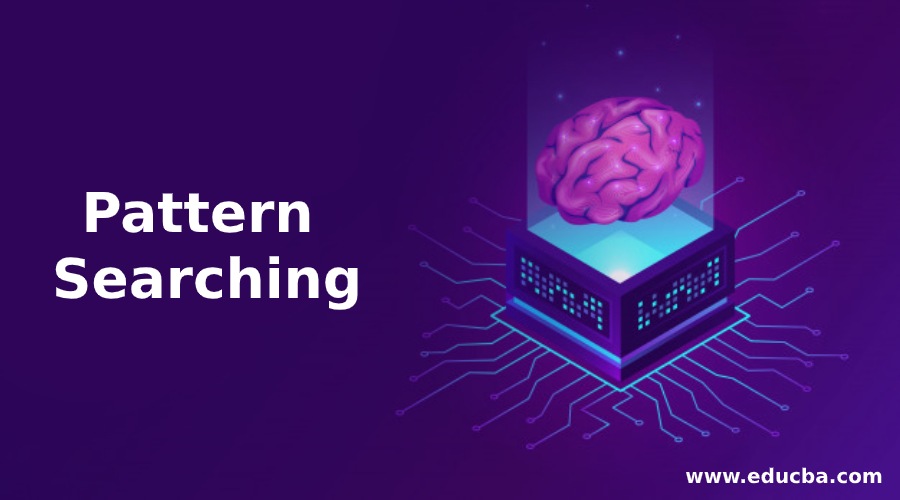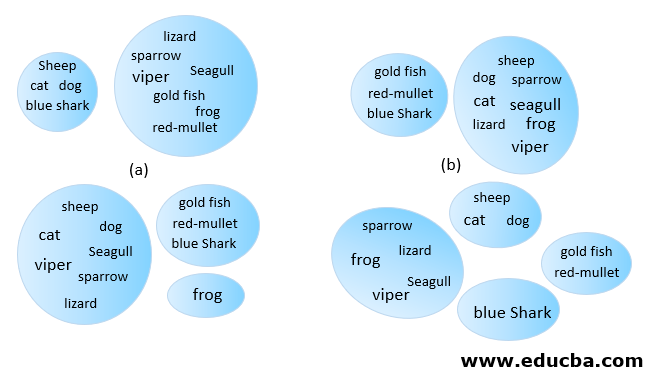Updated April 5, 2023

Introduction to Pattern Searching
Pattern searching is an imperative topic of Pattern recognition under the main element of AI. AI is the acronym for Artificial Intelligence and it gives way to machine learning in computer science. This is searching for any pattern that we want to like a string, word, image, etc. We use certain algorithms called pattern recognition to do the searching process. The complexity of pattern searching is O(m(n-m+1)). The algorithms are also known as String Searching Algorithms. These are very useful while we perform the search operation in the database. Pattern Searching algorithms are helpful in finding the patterns in substring from a bigger string. We have a variety of algorithms for this process. The main aim is to reduce time and space complexities.
The example is as follows:

Why do we need Pattern Searching?
Is this being the real question so as to why we need an algorithm for pattern recognition and searching? In the real scenario we have problems that need quick and efficient algorithms for computation. We have many applications that require searching process, and thus we are in dire need of pattern searching algorithms. There are various techniques available but we tend to organize the searching algorithms according to their usage and complexities appropriate for searching the results. The pattern search and matching method are one of these. In the example of web application we deal with various data and its sets, where we have to perform image, audio, text, string, video, etc. types of searching operation. There are many search engines, and they have different algorithms for this task in order to handle various types of data. The full search algorithm helps in increasing the efficiency of the matching task.
How does Pattern Searching work?
The main approach in searching takes a lot of time and space, while specified and well-designed algorithms are having greater efficiencies for longer search patterns. Here we will try to explore the working of the search operation for patterns and improved performances.
- We now know that this is one of the simple procedures for finding required patterns of data sets unlike pattern recognition, we need the match to be exact and precise.
- The sequences of patterns are fed as input to be searched and the locations are set where the searching of sequences takes place.
- Thus using a set of algorithmic steps the output is obtained. We can also substitute the pattern if required by search and replace option of the algorithm.
- It is a very common operation in various fields such as medical, web search, etc. The following figure shows one of the search procedures in execution.

Various search engines namely Google, yahoo, bing, etc. use these algorithms. The performance depends upon the algorithm’s capacity and complexity. Searching has now become a very popular task. In real-time applications it deals with a lot of complex operation and environment, the algorithm’s strength helps it to deal with these scenarios. We use Linear and Binary search algorithms basically for such tasks. The linear search task is to find the item from the database in a sequence which can be sorted or unsorted, while the binary search might be able to return the sorted sequence depending upon space and time requirements. The main steps are the comparisons and how large the datasets are for doing the search operation.
Algorithm Used For Matching and Pattern Searching
Each algorithm is unique and it thus has various usages according to their design and operation techniques. Let us explore a few of them.
1. The naive string search algorithm
This algorithm uses the simple or “naive” approach. It is simple and easier to implement. It is found to be slow sometimes. It works in a way that if the length of the text to be searched is M and the complete length of the Text is N, then the complexity is found as O(N*M).
2. Rabin Karp String Search Algorithm
This is a search algorithm for a searching pattern that uses a hashing method for its procedure and application. The length text is N and pattern M then length P, the complexity is O(N+M), O(P), and O(NM) for all three states.
3. Knuth–Morris–Pratt algorithm
This algorithm searches for words S inside the main text say T. It does so by searching within and if a mismatch happens then it reexamines the search string for another length.
4. Boyer–Moore string search algorithm
This algorithm is quite efficient in performing the string searching task. It does so by preprocessing the target pattern string and marks it as a key. It generally avoids the data set which is being searched for while focuses on the pattern only. The efficiency is found to be the result of unsuccessful search results.
Advantages of using Pattern Searching
There are many advantages fundamentally in web search applications. We have other advantages as well.
We will try to list a few of them here:
- Makes the efficient Search engine applications
- Online shopping, online medical diagnosis, online ventures, etc. rely on Search operation that reveals a certain set of patterns
- Pattern searching in the medical diagnosis of diseases
- It is helpful in Cyber forensics and Criminal Psychology study
- Image, Audio, Video search has become efficient than ever
- Algorithms of advanced complexities deal with large data sets for Data mining and data warehousing
- To handle data of multiple importance we could save the patterns for data extraction
- Pattern Search and matching help to find the right data at the right time and appropriate place.
Conclusion
In today’s world the search operation is so well known even by the child to an adult and an elderly. Everyone is interconnected by the internet so they perform various search operations all day around. Such tasks are eased by the Pattern searching algorithms. Each match is stored in the cache for future reference to improve the searching experience. From online search engines to online shopping, medical diagnosis and businesses are impacted by the Pattern searching operations in computer Science.
Recommended Articles
This is a guide to Pattern Searching. Here we discuss an introduction to Pattern Searching, why do we need it, How does it work and advantages. You can also go through our other related articles to learn more –


